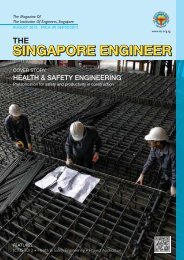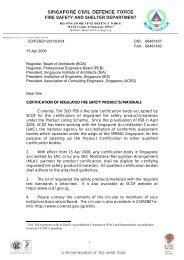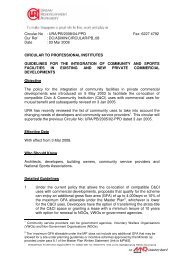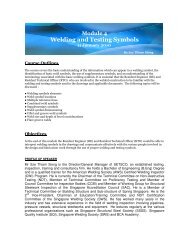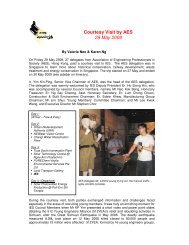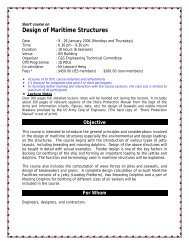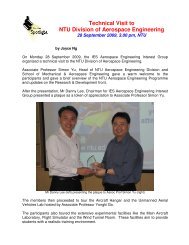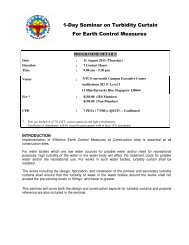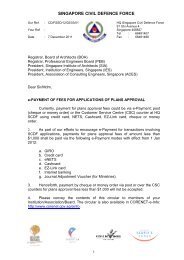News & Events - Institution of Engineers Singapore
News & Events - Institution of Engineers Singapore
News & Events - Institution of Engineers Singapore
Create successful ePaper yourself
Turn your PDF publications into a flip-book with our unique Google optimized e-Paper software.
Products & Services<br />
cost around £ 550,000 using conventional<br />
pavement reconstruction methods and<br />
would have taken longer and been<br />
more disruptive to road users and local<br />
residents’, said Mr Lansdown.<br />
‘The in-situ repair has proved to be<br />
operationally quicker on-site and can<br />
be trafficked almost straight away as<br />
a temporary running surface prior to<br />
applying the surface course. This has been<br />
my first experience <strong>of</strong> using the in-situ<br />
repair technique and would anticipate<br />
using it on similar road strengthening<br />
schemes in future’, he added.<br />
The in-situ recycling process, as<br />
practised by the specialist road recycling<br />
and stabilisation contractor, Stabilised<br />
Pavements, involves rotovating and<br />
pulverising damaged road pavements<br />
to depths <strong>of</strong> up to 320 mm. This is<br />
performed with a special purpose-built<br />
500 kW machine, while simultaneously<br />
mixing in specific predetermined<br />
quantities <strong>of</strong> either lime, cement,<br />
pulverised fuel ash (PFA), bitumen<br />
emulsion, or foamed bitumen, and<br />
water, or combinations <strong>of</strong> these<br />
ingredients.<br />
The revitalised mixture is then rolled,<br />
repr<strong>of</strong>iled, re-rolled, and overlaid with<br />
an appropriate final surfacing for a fast<br />
return to traffic. The process is performed<br />
in accordance with the Transport Research<br />
Laboratory TRL Report 386: ‘Design<br />
guide and specification for structural<br />
maintenance <strong>of</strong> highway pavements by<br />
cold in-situ recycling’.<br />
For Midford Road, Stabilised<br />
Pavements used a blend <strong>of</strong> 70% cement<br />
and 30% PFA, applied in a powder<br />
blanket across the surface <strong>of</strong> the rotovated<br />
material, to the extent <strong>of</strong> 8% by volume <strong>of</strong><br />
the dry in-situ material. The quantity <strong>of</strong> the<br />
strengthening agent was determined from<br />
pre-contract materials testing and mixed,<br />
in a one-pass operation, in Stabilised<br />
Pavements’ German Wirtgen WR 2500<br />
Recycler, at the designated depth <strong>of</strong> 180<br />
mm. Water was added into the mix at<br />
the same time to achieve the required<br />
optimum moisture content. The cement<br />
and PFA complement each other as the<br />
cement provides an initial gain in strength<br />
<strong>of</strong> the recycled road materials, while the<br />
PFA slows hydration and contributes to<br />
increasing the strength over time.<br />
Stabilised Pavements had to recycle<br />
Cold recycling with the WR 2500 S is an economically effi cient and environment-friendly method for<br />
producing base layers <strong>of</strong> superior quality.<br />
When cold recycling in-situ, the WR 2500 S granulates the existing pavement material while<br />
homogeneously mixing in binding agents and water at the same time. This method produces a new<br />
construction material mix in just one machine pass.<br />
and strengthen in-situ, 3,868 m 2 <strong>of</strong><br />
Midford Road, to a 180 mm depth<br />
<strong>of</strong> tar-bound hazardous material, and<br />
provide a 20-year design life for 2.5<br />
million standard axles. The approximate<br />
10 m wide carriageway was treated in<br />
two separate halves. Whilst one half <strong>of</strong><br />
the carriageway was being recycled and<br />
strengthened, the other half remained<br />
open for one-way traffi c along a short<br />
diversion route. Once the required<br />
levels and compaction were achieved,<br />
the surface <strong>of</strong> the in-situ repaired<br />
carriageway was sprayed with a sealing<br />
tack coat and gritted as a temporary<br />
running surface for traffi c. The process<br />
was then repeated for the other side <strong>of</strong> the<br />
carriageway using the adjacent recycled<br />
carriageway for one-way traffic.<br />
‘I believe in-situ recycling has to be<br />
the way forward for treating tar-bound<br />
roads in the UK, which also provides<br />
the additional bonus <strong>of</strong> a saving on CO 2<br />
emissions’, said Mr Gerry Howe, Director,<br />
Stabilised Pavements.<br />
Although the in-situ recycled and<br />
stabilised base course bulked-up during<br />
processing, the Design Group adjusted<br />
the centre-line crown levels for the new<br />
road surface. The crown was raised by<br />
80 mm, and 10 mm along the channels,<br />
increasing the cross falls to between 6%<br />
and 7%. Atkins’s surfacing contractor<br />
Bardon Contracting followed on and<br />
overlaid Stabilised Pavements’ rejuvenated<br />
full width road base with a 50 mm thick<br />
hot rolled asphalt surface course for a fast<br />
return to full traffic.<br />
THE SINGAPORE ENGINEER Jun 2010 · 37



